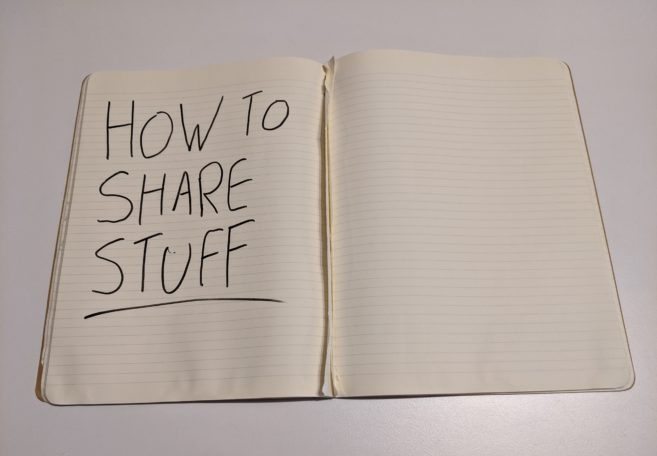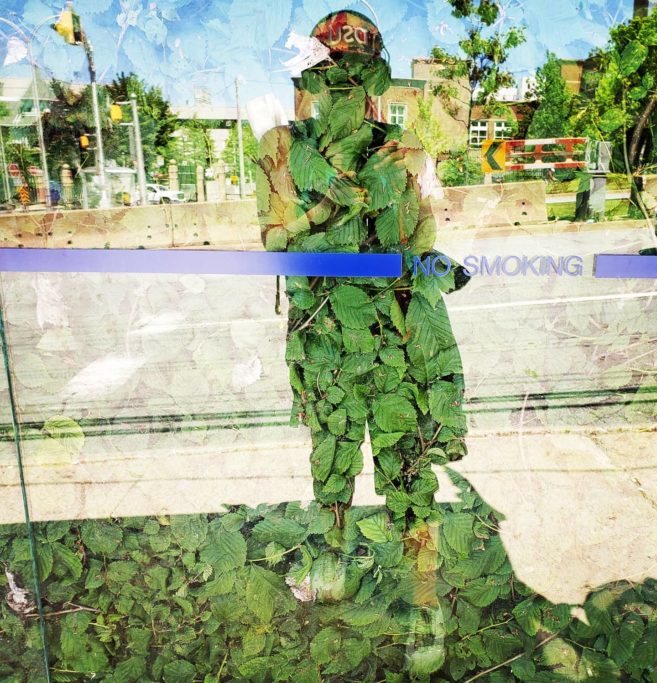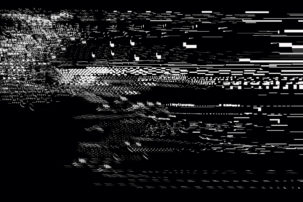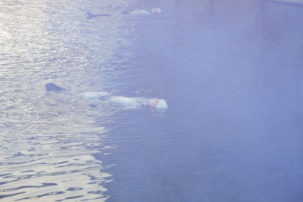In advance of the inaugural Toronto Biennial this fall, Canadian Art is publishing a weekly series of behind-the-scenes features from artists, curators and participants in which they discuss the research and processes that inform their practices.
In an era when many Canadian institutions have land acknowledgments, are gestures that pay lip service to territorial recognition, often driven by performative identity politics, actually limiting meaningful relationship-building between Indigenous peoples and Canadian institutions? Worse still, given the recent public outcry over Toronto Pride’s land acknowledgement, have these become just another way to police one another? Ilana Shamoon, deputy director and director of programs for the Toronto Biennial, asked artist and biennial advisor Ange Loft to develop a land acknowledgment document that carefully considered place, space and land in Toronto. Loft’s document is living and reflexive, as Toronto Biennial senior curator Candice Hopkins contends that any land acknowledgment should be, and it’s grounded in community knowledge, relationality and oral histories—instead of authoritative colonial documentation. Loft has supported the work of the Biennial, its curators and its artists, with a document the embodies material relationships with land—ones based in site, story, symbols and imagery—just like the Indigenous material forms that were, and are still, used to record governance agreements.—Lindsay Nixon
Ange Loft: The Toronto Indigenous Context Brief is thinking about the images that were in Toronto, and the images that are missing in Toronto. The document consists of three huge layers. One of the layers begins from around 10,000 years ago, maybe 11,000 years ago, and continues through until about 1660—a huge span of territory, time and thinking about this area in particular. The Land Acknowledgement document is talking a lot about the symbols, names, words and language that’s important to have when speaking about the Huron-Wendat and the Indigenous nations that were here. For instance, the people of the Bear Clan lived here, or the people who lived here might have been Wolf Clan people, and it’s important to put in the document what they call themselves. And then we moved through some of the ideas around the Haudenosaunee symbols of governance. It was important to talk through governance using symbols because when I see these images, it’s easy for me to use them as mnemonic devices to explain narratively. So I was using symbols in the document—using a Hiawatha belt, the stories held inside the Haudenosaunee Confederacy, such as the 50 Chiefs Belt, and the Confederacy logo—to describe basic governance structures, purely to put on the table another way to make choices here, to think about Toronto not only as a municipality but as a place that has a long legacy of dealing with the way people negotiate things.
A lot of the document is research I’ve done independently and in collaboration with my collaborator on the Talking Treaties project, Victoria Freeman. So we had a lot of ideas brewing for a long time about framing Toronto around foundational agreements. The document discusses people who have been here for a long time: the people who had Huron-Wendat negotiations, the Haudenosaunee negotiations with the then-incoming Anishinaabe folks and the other many nations that they had living here too. So, then I walk through a couple Anishinaabe images. I wanted to drop a little bit in about Anishinaabe land-based decision-making structures just to have another framework for the way that things can be tossed between people. We broke down the iconography of the local Mississaugas of the Credit First Nation: the eagle, the three fires, the Tomahawk and the peace pipe. Those icons become story devices for Toronto. It was really exciting to think about Toronto that way. The first layer of the document is particularly interesting because there are things that can or cannot be proven. There is a lot of reference to a red ochre burial in High Park, which is from a 1920s article that can no longer be verified. So the document includes these stories that lead you down controversial routes but also holds an oral memory of people. There were stories about bones at Bloor and Bay—these ideas of burial grounds being disrupted and not all people agreeing that it happened; that is still a story that’s held in the hearts of Toronto Native populations for sure. I think the document needs a lot more public information; it needs a lot more people’s voices in there. And it needs to be a living document. It was created in such a way as to overwhelm whomever the curator would be, to overwhelm people with really feeling like there is a depth to this place and there are super complicated narratives. You can’t say just one thing about this place, because it’s so multifaceted.
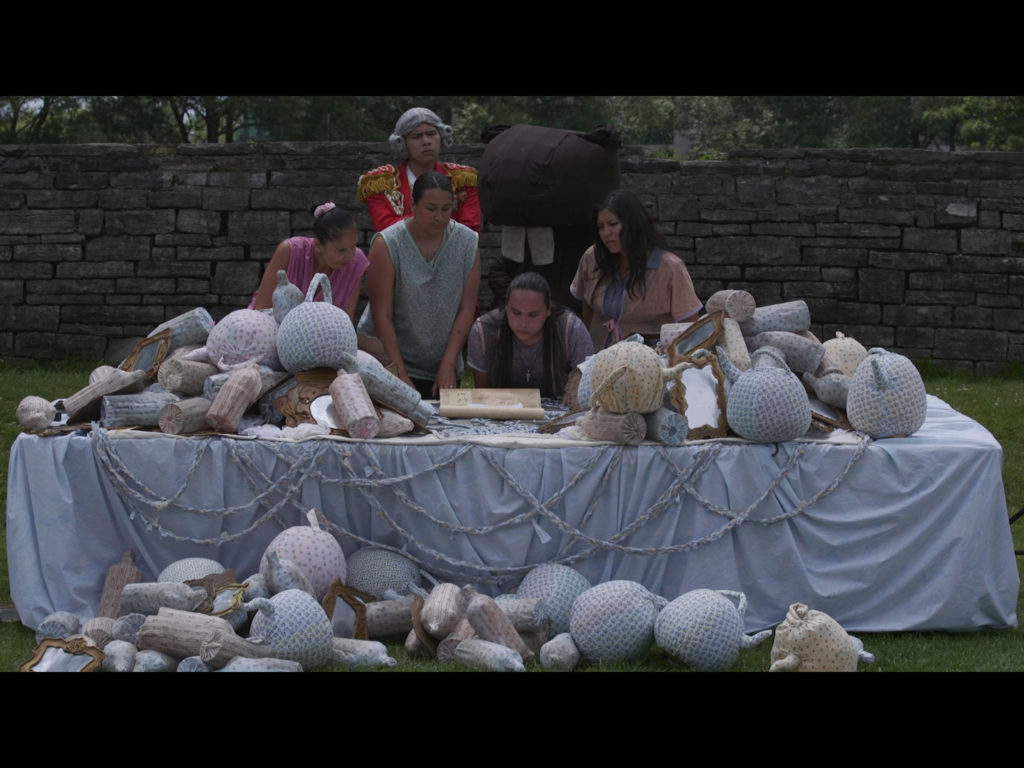 Video still from By These Presents: “Purchasing” Toronto, a Talking Treaties installation by Ange Loft, Martha Stiegman and Victoria Freeman, 2019. Edited by Amy Siegel and Adrienne Marcus Raja. Commissioned by the Toronto Biennial and produced by Jumblies Theatre. Courtesy Jumblies Theatre.
Video still from By These Presents: “Purchasing” Toronto, a Talking Treaties installation by Ange Loft, Martha Stiegman and Victoria Freeman, 2019. Edited by Amy Siegel and Adrienne Marcus Raja. Commissioned by the Toronto Biennial and produced by Jumblies Theatre. Courtesy Jumblies Theatre.
Lindsay Nixon: Candice, what does it mean then, as a curator, to work from a document like this and do site-specific curation while thinking about Indigenous relationships to the land we are on right now?
Candice Hopkins: What Ange has proposed is the idea that history is not a straight line. Ange has offered a stratified idea of what that might be—not only stratified but also locational. And within that, Ange has these voices that sometimes contradict each other. If you were really to understand how these frameworks are made, you shouldn’t shy away from contradiction and should think about contradiction of places. There is no singular narrative. And I thought that it was quite profound that, even before we, Tairone Bastien and I, were brought on board as curators, this document had already been commissioned, along with a curatorial framework that Ilana had drafted in consultation with many other exhibition-makers. From the beginning, we were thinking about how so many people think of site as simply a place, especially along the shoreline where a lot of the land was quite literally invented or manufactured for industry or ports.
Then this document becomes a kind of guiding document. The thing that really resonated with artists—this also goes back to Ange’s practice—is that the document is based on iconographies. And these iconographies—such as the belt to the 24 nations and the Treaty of Hiawatha—had different visual manifestations. So to think about how these visual manifestations then inflect histories is, I think, very important. What does it mean for artists to start a project from this layer and idea of history, instead of the way it’s been narrated by the city or from these other perspectives?
First and foremost, this is a working document. Ange is not trying to instill the idea of an official narrative. In fact, she’s interested in how there are many unofficial narratives and how to represent that. I know there was a lot of worry about what happens when you put that on the page—does it become fixed? Ange was clear that that’s also why she didn’t want this document to be distributed, because it’s meant to act more as a framework—so it became one of the frameworks that we worked with, and that the artists worked with.
Ilana Shamoon: Ange, did you think about the symbolism in the document as a counter, in some ways, to the maps themselves? We talked a lot about mapping as an exercise—maps being a colonial tool and not necessarily reflecting various Indigenous approaches to the land. But we ultimately landed on a map for its clarity and immediacy, as the primary goal was about how to communicate this work to the curatorial team. When I approached Ange, we didn’t know who the curators were going to be. So when developing the document we were considering how to convey certain ideas and give some tangible points of entry for curators who may have no connection to Canada—at that point, we just didn’t know what the curatorial process was going to look like.
AL: We met a couple times and cut up documents, put things together on a table and tried to figure out which parts relate to which area in Toronto. I just kept saying, I think it’s important to tell these stories using the actual images. So, I was able to wrap little bits of information around symbols or around some document. For example, we’re looking at an old French map of the area and looking at the old names for the villages where the Haudenosaunee people were, or looking at an old Archeological Services scan of what a site looked like. The document is a combination of how I like to tell stories and of Ilana pointing out, “Oh right, this is actually really important,” and trying to summarize the ideas that I had already laid out for the framework of Talking Treaties.
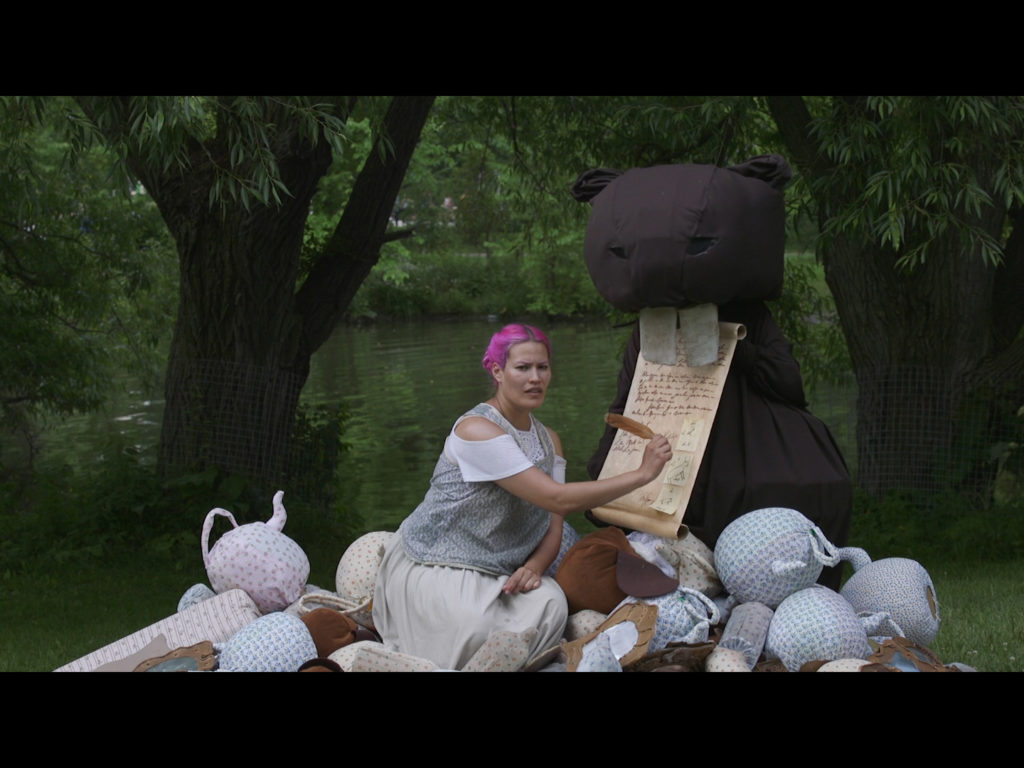
Video still from By These Presents: “Purchasing” Toronto, a Talking Treaties installation by Ange Loft, Martha Stiegman and Victoria Freeman, 2019. Edited by Amy Siegel and Adrienne Marcus Raja. Commissioned by the Toronto Biennial and produced by Jumblies Theatre. Courtesy Jumblies Theatre.

Video still from By These Presents: “Purchasing” Toronto, a Talking Treaties installation by Ange Loft, Martha Stiegman and Victoria Freeman, 2019. Edited by Amy Siegel and Adrienne Marcus Raja. Commissioned by the Toronto Biennial and produced by Jumblies Theatre. Courtesy Jumblies Theatre.

Video still from By These Presents: “Purchasing” Toronto, a Talking Treaties installation by Ange Loft, Martha Stiegman and Victoria Freeman, 2019. Edited by Amy Siegel and Adrienne Marcus Raja. Commissioned by the Toronto Biennial and produced by Jumblies Theatre. Courtesy Jumblies Theatre.
CH: A central point of Talking Treaties (which is a theatre performance that also is a workshop, and now will be an art installation as part of the Biennial) is the physical replication of goods by settlers, which were then misrepresented as if to say, we’ve given you these goods and now we have an agreement for the land. Many Indigenous people saw the goods as a diplomatic gesture but not as a gesture of agreement. With Talking Treaties, you’ve reiterated these goods and you’ve physically made them and now they become part of an installation. I think it again goes back to this idea that there were not only commodities, things like fur, but also commodities that were exchanged on behalf of land, that became dubious objects.
LN: And Ilana, in your lead-up work you felt compelled that this document was an important thing that you wanted the Biennial work to be grounded in.
IS: I have been thinking about site-specificity for a long time, and my consideration of it was amplified in my work in public art. During my time running the public art program at Waterfront Toronto, I did a lot of research on public art calls, what they looked like generally, and how they convey a site’s history or context. I was really surprised, considering the conversations that are happening in Canada, about the shortsightedness of many of these documents. They’d go back like only 100 or 150 years, to reference a site’s industrial or colonial histories. I started thinking about how to disrupt this. I felt that for the Biennial, it would be a really important exercise to contextualize site in a deeper way. We wanted to ensure that the event is anchored here, and providing our team and participants with research on the continuous Indigenous presence in the area seemed like the logical starting point—this was obviously not something that that I could lead, and Clayton Windatt, a mutual friend and colleague, introduced me to Ange.
The idea of layers, which Ange conceived of, has been incredibly fruitful for all of us in terms of how we think about place—it is so open and inclusive—and implies adding on instead of erasing. I remember updating Julie Crooks, assistant curator of photography at the AGO, on our project over a year ago, for example, and she got excited thinking about layering the Black histories of this area onto Ange’s work. There is no end to the potential layering.
CH: I also think about this document as an extension of Ange’s practice: how it relates Ange’s land acknowledgment–generator kit workshop. I understand land acknowledgments as an agreement to a certain version of her understanding of what history is and also current relationships. What Ange does with this document is, first, she creates narratives through images. History becomes inert when it’s simply performed or gets orated over and over again, so that it becomes meaningless. What happens when you shift that and you have these personal implications? This conditional document starts to shift that, as well.
AL: I added a lot of lists and things about tangible, physical objects to it. For instance, in 1764, what was the cost of a blanket? It was two beavers. Or what was the cost of a bottle of rum? It was one beaver. There’s a list of prices and that was the list that all the fur traders used for the whole area and all the Native nations that agreed to that. Twenty-four nations, and they all agreed to these prices at that time. So, I’m thinking about how these agreements and what their visual depictions were, and how they are not outside of our collective memory and they’re not outside of our current needs. When we talk about treaty-making and agreement-making and how we agreed to share Toronto and what we decide to do here, it’s actually talking about physical, tangible things. It was really interesting to be able to lay that all out: the different perspectives on what you can pay for here how you can look at this place in regard to images. But we’re not talking about the paper and the written-down documents and bringing them to an image-based place. This place has always had a price on things.

